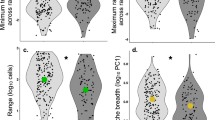Summary
I examined the hypothesis that the clutch size of some altricial birds may be limited by over-crowding of the nestlings in the nest, by comparing data on different species of European passerines. Large-sized birds build, relative to the body, larger nests than small-sized birds, both as regards the inner and the outer nest widths and as regards edge breadth; only inner nestcup depth did not change relatively to body size. Nest size also varied in relation to nesting place. Birds with open nests built off the ground had a rather narrow nestcup, whereas those with a domed nest, or which nest in a cavity, had a wide nestcup. When only open-nesters were compared, birds nesting on, or close to, the ground tended to have a wider nestcup than birds nesting above the ground. Inner nestcup width was correlated with the amount of mosses and lichens used in building the nest; the more of such materials the narrower the nestcup. The three variables: standardised body size, nesting place, and type of nesting material used accounted for 92% of the overall variation observed in inner nestcup width. When controlling for adult body size, clutch size was positively correlated with the size of the nestcup. A multiple regression analysis showed that relative nestcup depth, nest site, and type of nesting materials used, accounted for 64% of the overall variation in clutch size.
Similar content being viewed by others
References
Balen JH van (1984) The relationship between nest-box size, occupation and breeding parameters of the Great Tit Parus major and some other hole-nesting birds. Ardea 72:163–175
Braun BM, Hunt GL Jr (1983) Brood reduction in Black-legged Kittiwakes. Auk 100:469–476
Collias NE, Collias EC (1984) Nest building and bird behaviour. Princeton University Press, Princeton
Haartman L von (1969) The nesting habits of Finnish birds. I. Passeriformes. Commental Biol 32:1–187
Haftorn S (1971) Norges fugler. Universitetsforlaget, Oslo
Karlsson J, Nilsson SG (1977) The influence of nest-box area on clutch size in some hole-nesting passerines. Ibis 119:207–211
Klomp H (1970) The determination of clutch-size in birds. A review. Ardea 58:1–124
Lack D (1968) Ecological adaptations for breeding in birds. Methuen. London
Lima SL (1987) Clutch size in birds: a predation perspective. Ecology 68:1062–1070
Ludescher F-B (1973) Sumpfmeise (Parus p. palustris L.) und Weidenmeise (P. montanus salicarius Br.) als sympatrische Zwillingsarten. J Orn 114:3–56
Lörhl H (1980) Weitere Versuche zur Frage “Brutraum und Gelegegrösse” bei der Kohlmeise, Parus major. J Orn 121:403–405
Martin TE (1989) Nest placement: implications for selected lifehistory traits, with special reference to clutch size. Am Nat 132:900–910
Murphy EC, Haukioja E (1986) Clutch size in indicolous birds. In: Johnston RF (ed) Current ornithology 4. Plenum Press, New York, pp 141–180
Møller AP (1982) Clutch size in relation to nest size in the Swallow Hirundo rustica. Ibis 124:339–343
Møller AP (1984) On the use of feathers in birds' nests: predictions and tests. Ornis Scand 15:38–42
Nice MM (1957) Nesting success in altricial birds. Auk 74:305–321
Nilsson SG (1984) The evolution of nest-site selection among holenesting birds: the importance of nest predation and competition. Ornis Scand 15:167–175
Nilsson SG (1986) Evolution of hole-nesting in birds: on balancing selection pressures. Auk 103:432–435
Perrins CM (1977) The role of predation in the evolution of clutch size. In: Stonehouse B, Perrins CM (eds) Evolutionary ecology. Macmillan Press, London, pp 181–191
Perrins CM, Moss D (1975) Reproductive rates in the Great Tit. J Anim Ecol 44:695–706
Ricklefs RE (1969) An analysis of nestling mortality in birds. Smithsonian Contrib Zool 9:1–48
Skagen SK (1987) Hatching asynchrony in American Goldfinches: an experimental study. Ecology 68:1747–1759
Slagsvold T (1982a) Clutch size variation in passerine birds: the nest predation hypothesis. Oecologia (Berlin) 54:159–169
Slagsvold T (1982b) Clutch size, nest size, and hatching asynchrony in birds: experiments with the Fieldfare (Turdus pilaris). Ecology 63:1389–1399
Slagsvold T (1984) Clutch size variation of birds in relation to nest predation: on the cost of reproduction. J Anim Ecol 53:945–953
Slagsvold T (1986) Hatching asynchrony: interspecific comparisons of altricial birds. Am Nat 128:120–125
Slagsvold T, Sandvik J, Rofstad G, Lorentsen Ø, Husby M (1984) On the adaptive value of intraclutch egg-size variation in birds. Auk 101:685–697
Snapp BD (1976) Colonical breeding in the Barn Swallow (Hirundo rustica) and its adaptive significance. Condor 78:471–480
Snow DW (1978) The nest as a factor determining clutch-size in tropical birds. J Orn 119:227–230
Sæther B-E (1985) Variation in reproductive traits in European passerines in relation to nesting site: allometric scaling to body weight or adaptive variation? Oecologia (Berlin) 68:7–9
Author information
Authors and Affiliations
Rights and permissions
About this article
Cite this article
Slagsvold, T. On the evolution of clutch size and nest size in passerine birds. Oecologia 79, 300–305 (1989). https://doi.org/10.1007/BF00384308
Received:
Published:
Issue Date:
DOI: https://doi.org/10.1007/BF00384308



